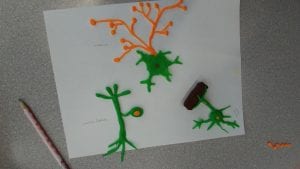Neuron Structure:
Neuron Function:
Neurons are composed of the cell body (the largest volume section, which looks like a fried egg.), dendrites (conduct messages towards the cell body, fibres carrying incoming messages. Receiving and bringing nerve messages to the cell body), and the axon (conduct message away from the cell body, it takes the message from the cell body and sends it out to the next cell in the chain of communication. Neurons communication through action potential — A brief electrical charge that travels down an axon through the movement of positive ions in and out.
– Depolarization: incoming message stimulates section of the axon, channels in membrane open to allow Na+ ions to enter the axon
– Repolarization: Channels open that allow K+ ions to exit axon, which causes the next segment of the axon to depolarize. Therefore, creating a flow of depolarization — a sequential depolarization/repolarization causing the AP to move smoothly down the axon.
Synapse Structure:
Synapse function:
The Synapse includes: tips of terminal branches of the axon, tiny spaces between neurons, the synapse is the space between the dendrite and the axon, ends of dendrites of receiving neuron. The Axon terminal branch produces neurotransmitters which are used to mediate neurons and its signals.
-This is done through the AP causing synaptic vesicles to release NT into the synaptic gap. The NT diffuses through the gap and binds to receptors on receiving neurons.
– In the NT, the message is then received as excitatory (stimulates AP on receiving neuron) or inhibitory (represses AP on receiving neuron) This is decided whether the neuron reaches is threshold — which must be met in order for it to be excitatory.



